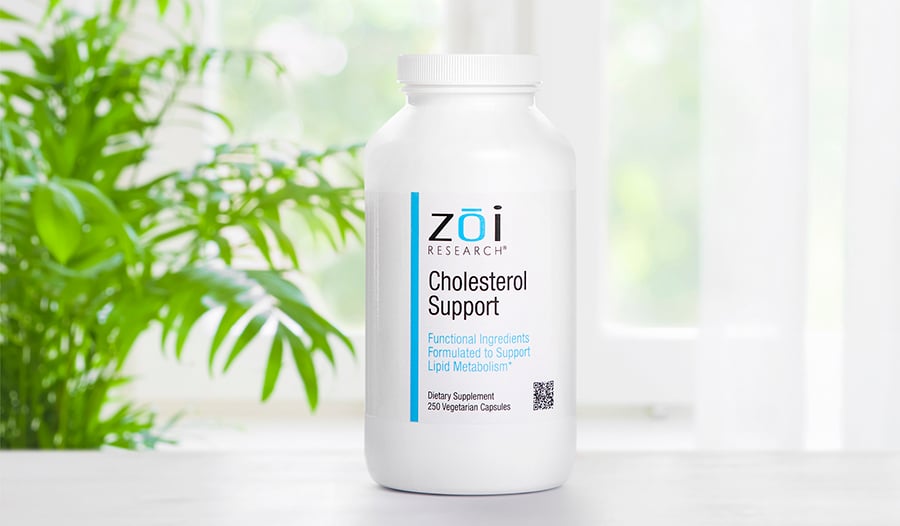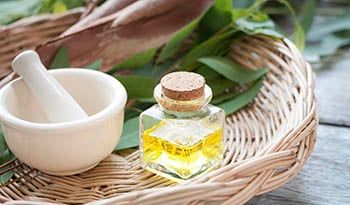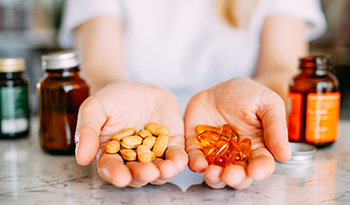Cholesterol Health Tips from a Doc: Supplements, Lifestyle, Nutrition

Has your doctor told you that your cholesterol is too high? If so, you’re not alone! Over 30% of adults in the United States have hypercholesterolemia, also known as high cholesterol.
This article will cover natural approaches to optimizing cholesterol levels, including exercise, supplements, dietary approaches, medications, etc. We’ll answer each of the following questions:
- What is cholesterol?
- Why is high cholesterol bad for you?
- How can you lower cholesterol naturally?
- Why is low cholesterol bad for you?
- How can you raise cholesterol naturally?
What Is Cholesterol?
Cholesterol is a type of fat that is made in human cells and the liver. Cholesterol is packaged into tiny particles and travels through the bloodstream to different organs in the body, where it is used to make hormones, vitamins, and digestive enzymes or bile salts.
Some of the products the body makes from cholesterol include:
- Hormones like testosterone, estrogen, progesterone, and DHEA
- Vitamin D
- Bile salts, which help the body absorb dietary fats and fat-soluble vitamins like vitamins A, D, E, and K
- Brain tissue
- Cell membranes
Why Is High Cholesterol Bad for You?
After reading the description above, you may be starting to understand that cholesterol is critical for the proper functioning of our bodies. But you can have too much of a good thing.
When cholesterol fats in the bloodstream build up, the blood can become fatty and thick rather than fluid-like and watery. This isn’t good, particularly as blood tries to make its way through very small arteries to get to places like the eyes, kidneys, toes, and brain.
Additionally, when blood is too fatty it is far more likely to form plaque in arterial walls, which can eventually clog arteries to the point where blood is not able to get through. When blood can’t travel to the organs that need it, those organs start to die due to a lack of oxygen and nutrients.
One example of this is a heart attack, also known as myocardial infarction. Death of organ tissue due to lack of blood flow and oxygen is called “ischemia” or “ischemic damage”.
When your doctor talks to you about lowering your high cholesterol, it is because they want to protect your heart and other organs from ischemic damage, which can be deadly.
Hopefully, you now understand why it’s so important for cholesterol to not be too high!
How High Is Too High?
The right level of cholesterol for you depends on your genetics, risk factors, lifestyle, and cardiac history. To calculate your ideal cholesterol, you and your doctor can use an online ASCVD risk calculator.
New research suggests that cholesterol needs may vary by age and gender even more than we previously thought, making “high cholesterol” a relative term. Whatever you and your doctor decide as your target—and how quickly you need to get there to stay healthy and safe—will determine which therapy you choose to lower your cholesterol.
People with mildly high cholesterol and no risk factors can use gentle, natural methods to lower their cholesterol slowly, while people with very high cholesterol and several dangerous risk factors may opt for prescription-strength interventions to quickly reduce their risk of a cardiovascular event due to ischemia.
How to Lower Cholesterol Naturally
If your cholesterol is mildly high and you have no risk factors, you may be able to lower your cholesterol with the following natural methods.
Supplements
- Red yeast rice: Red yeast rice is one of the best-studied supplements for lowering cholesterol. Like statins, it can significantly lower cholesterol when taken over several months. Also, like statin drugs, it can deplete CoQ10, so it’s wise to consume a supplement that contains both red yeast rice and CoQ10.
- Fiber: Plant fibers at doses of 5 to 10 grams per day can also lower cholesterol. You can take fiber in the form of a fiber supplement or eat high-fiber foods like figs, almonds, lentils, beans, broccoli, walnuts, potatoes, and more.
Lifestyle
- Exercise: Regular exercise can reduce cholesterol. To lower cholesterol, aim for 30 minutes of exercise 5 times per week, including both moderately difficult aerobic exercise as well as strength training.
- Donate blood: Donating blood regularly may reduce cholesterol.
- Quit smoking: People with high cholesterol should quit smoking to reduce their risk of cardiovascular events.
Nutrition
- Adopt a heart-healthy diet: Dietary plans like the DASH diet, Mediterranean diet, Paleo diet, and others that contain an abundance of plant and whole foods have been found to lower cholesterol over time.
- Eat less saturated fat: People with high cholesterol are advised to minimize foods high in saturated fats, like fatty meats, whole-fat dairy products, and palm oil.
Other Strategies to Lower Cholesterol Naturally
Optimize Thyroid Function
Underactive thyroid, also known as hypothyroidism, can cause hypercholesterolemia. Some people have functionally low thyroid levels due to insufficient intake of nutrients like tyrosine, selenium, iron, and iodine. You can work with a doctor or registered dietitian to determine whether this is true for you and devise a plan to fix it as part of a holistic approach.
Optimize Liver Function
Liver diseases like fatty liver can increase cholesterol levels. Some supplements that may help support liver health include milk thistle, glutathione, B vitamins, and vitamin C. Discuss these with your doctor to see if adding them to your regimen may help to improve lipid and liver health over time.
Improve Blood Sugar Control
Chronically high blood sugar and its effects on the body increase the risk for high cholesterol. To lower cholesterol naturally, consider practices for lowering blood sugar, like a low glycemic diet, regular exercise routine, adequate sleep, and intermittent fasting, if your doctor prescribes it. Some supplements may help improve insulin response and lower blood sugar, like berberine and garcinia cambogia.
Can Your Cholesterol Be Too Low?
Yes. Remember that cholesterol is used to make brain tissue, vitamin D, cell membranes, hormones, and more. Cholesterol levels under 160mg/dL are considered functionally low by many practitioners, and total cholesterol levels below 100mg/dL are very dangerous. People with malabsorptive disorders and who’ve been taking statins without monitoring their cholesterol levels are at risk for low cholesterol.
How to Fix Low Cholesterol
Correct Malabsorption
If you have celiac disease, avoid gluten and work with a registered dietitian to design a nutrient-replete, gluten-free meal plan that corrects nutrient deficiencies while still allowing you to avoid sources of gliadin and glutenin.
If pancreatic or other enzyme deficiencies are at the root of your low cholesterol, you could consider supplementing with digestive enzymes along with a comprehensive plan recommended by your doctor.
Don’t Over-take Statins or Neglect Routine Monitoring and Follow Up
Remember, too much of a good thing is never a good thing! Long-term statin use can cause low cholesterol. When your doctor tells you that you need to follow up or get blood work in a few months to make sure your cholesterol medications are working, listen! It could save your life.
Takeaway
Cholesterol is critical for optimal body functioning—but too much or too little can lead to disease. This article gives you some great tips to discuss with your doctor when creating a whole-person plan to optimize your cholesterol levels.
References:
- Abbate SL;Brunzell JD. “Pathophysiology of Hyperlipidemia in Diabetes Mellitus.” Journal of Cardiovascular Pharmacology, vol. 16 Suppl 9, 2022, pubmed.ncbi.nlm.nih.gov/1710739/. Accessed 17 May 2022.
- Akinbami, Akinsegun, et al. “Lipid Profile of Regular Blood Donors.” Journal of Blood Medicine, May 2013, p. 39, www.ncbi.nlm.nih.gov/pmc/articles/PMC3663474/, 10.2147/jbm.s42211. Accessed 31 May 2022.
- Barrios, Vivencio, et al. “A Nutraceutical Approach (Armolipid Plus) to Reduce Total and LDL Cholesterol in Individuals with Mild to Moderate Dyslipidemia: Review of the Clinical Evidence.” Atherosclerosis Supplements, vol. 24, Feb. 2017, pp. 1–15, pubmed.ncbi.nlm.nih.gov/27998714/, 10.1016/j.atherosclerosissup.2016.10.003. Accessed 15 May 2022.
- Blom, Wendy A. M., et al. “A Low-Fat Spread with Added Plant Sterols and Fish Omega-3 Fatty Acids Lowers Serum Triglyceride and LDL-Cholesterol Concentrations in Individuals with Modest Hypercholesterolaemia and Hypertriglyceridaemia.” European Journal of Nutrition, vol. 58, no. 4, 3 May 2018, pp. 1615–1624, pubmed.ncbi.nlm.nih.gov/29725824/, 10.1007/s00394-018-1706-1. Accessed 8 Oct. 2021.
- Cha, Dongjoo, and Yongsoon Park. “Association between Dietary Cholesterol and Their Food Sources and Risk for Hypercholesterolemia: The 2012–2016 Korea National Health and Nutrition Examination Survey.” Nutrients, vol. 11, no. 4, 15 Apr. 2019, p. 846, pubmed.ncbi.nlm.nih.gov/30991629/, 10.3390/nu11040846. Accessed 15 May 2022.
- Chiavaroli, Laura, et al. “Portfolio Dietary Pattern and Cardiovascular Disease: A Systematic Review and Meta-Analysis of Controlled Trials.” Progress in Cardiovascular Diseases, vol. 61, no. 1, May 2018, pp. 43–53, pubmed.ncbi.nlm.nih.gov/29807048/, 10.1016/j.pcad.2018.05.004. Accessed 15 May 2022.
- Chiu, Sally, et al. “Comparison of the DASH (Dietary Approaches to Stop Hypertension) Diet and a Higher-Fat DASH Diet on Blood Pressure and Lipids and Lipoproteins: A Randomized Controlled Trial1–3.” The American Journal of Clinical Nutrition, vol. 103, no. 2, 30 Dec. 2015, pp. 341–347, pubmed.ncbi.nlm.nih.gov/26718414/?from_term=lowering+triglycerides+diet&from_pos=3, 10.3945/ajcn.115.123281. Accessed 10 May 2020.
- Cicero, Arrigo F.G., et al. “Red Yeast Rice for Hypercholesterolemia.” Methodist DeBakey Cardiovascular Journal, vol. 15, no. 3, 1 July 2019, p. 192, pubmed.ncbi.nlm.nih.gov/31687098/, 10.14797/mdcj-15-3-192. Accessed 15 May 2022.
- Clifton, Peter M. “Diet, Exercise and Weight Loss and Dyslipidaemia.” Pathology, vol. 51, no. 2, Feb. 2019, pp. 222–226, pubmed.ncbi.nlm.nih.gov/30528924/?from_term=lowering+triglycerides+diet&from_pos=1, 10.1016/j.pathol.2018.10.013. Accessed 10 May 2020.
- Di Ciaula, Agostino, et al. “Bile Acid Physiology.” Annals of Hepatology, vol. 16, Nov. 2017, pp. S4–S14, pubmed.ncbi.nlm.nih.gov/29080336/, 10.5604/01.3001.0010.5493. Accessed 21 Aug. 2022.
- “Familial Hypercholesterolemia: MedlinePlus Medical Encyclopedia.” Medlineplus.gov, 2019, medlineplus.gov/ency/article/000392.htm#:~:text=Familial%20hypercholesterolemia%20is%20a%20disorder,Familial%20combined%20hyperlipidemia. Accessed 15 May 2022.
- Ferro, Charles J., et al. “Lipid Management in Patients with Chronic Kidney Disease.” Nature Reviews Nephrology, vol. 14, no. 12, 25 Oct. 2018, pp. 727–749, pubmed.ncbi.nlm.nih.gov/30361677/, 10.1038/s41581-018-0072-9. Accessed 17 May 2022.
- Gylling, Helena, et al. “Plant Sterols and Plant Stanols in the Management of Dyslipidaemia and Prevention of Cardiovascular Disease.” Atherosclerosis, vol. 232, no. 2, Feb. 2014, pp. 346–360, pubmed.ncbi.nlm.nih.gov/24468148/, 10.1016/j.atherosclerosis.2013.11.043. Accessed 15 May 2022.
- “High Cholesterol - Symptoms and Causes.” Mayo Clinic, 2021, www.mayoclinic.org/diseases-conditions/high-blood-cholesterol/symptoms-causes/syc-20350800#:~:text=High%20cholesterol%20has%20no%20symptoms,detect%20if%20you%20have%20it.. Accessed 15 May 2022.
- Huff, Trevor, et al. “Physiology, Cholesterol.” Nih.gov, StatPearls Publishing, 9 Mar. 2022, www.ncbi.nlm.nih.gov/books/NBK470561/. Accessed 21 Aug. 2022.
- “Hypercholesterolemia - Symptoms, Diagnosis and Treatment | BMJ Best Practice US.” Bmj.com, 2022, bestpractice.bmj.com/topics/en-us/170. Accessed 14 May 2022.
- Ibrahim, Michael A, et al. “Hypercholesterolemia.” Nih.gov, StatPearls Publishing, 7 Nov. 2021, www.ncbi.nlm.nih.gov/books/NBK459188/. Accessed 14 May 2022.
- Ioannou, George N. “The Role of Cholesterol in the Pathogenesis of NASH.” Trends in Endocrinology & Metabolism, vol. 27, no. 2, Feb. 2016, pp. 84–95, www.cell.com/trends/endocrinology-metabolism/fulltext/S1043-2760(15)00233-7?_returnURL=https%3A%2F%2Flinkinghub.elsevier.com%2Fretrieve%2Fpii%2FS1043276015002337%3Fshowall%3Dtrue, 10.1016/j.tem.2015.11.008. Accessed 17 May 2022.
- Kelley, GA, and KS Kelley. “Impact of Progressive Resistance Training on Lipids and Lipoproteins in Adults: A Meta-Analysis of Randomized Controlled Trials.” Nih.gov, Centre for Reviews and Dissemination (UK), 2014, www.ncbi.nlm.nih.gov/books/NBK77269/. Accessed 29 May 2022.
- Lee, Jun-Hyuk, et al. “Non-Alcoholic Fatty Liver Disease Is an Independent Risk Factor for LDL Cholesterol Target Level.” International Journal of Environmental Research and Public Health, vol. 18, no. 7, 26 Mar. 2021, p. 3442, www.ncbi.nlm.nih.gov/pmc/articles/PMC8037151/, 10.3390/ijerph18073442. Accessed 17 May 2022.
- Li, Heng, et al. “Hepatic Cholesterol Transport and Its Role in Non-Alcoholic Fatty Liver Disease and Atherosclerosis.” Progress in Lipid Research, vol. 83, July 2021, p. 101109, www.sciencedirect.com/science/article/abs/pii/S0163782721000254?via%3Dihub, 10.1016/j.plipres.2021.101109. Accessed 17 May 2022.
- Mach, François, et al. “2019 ESC/EAS Guidelines for the Management of Dyslipidaemias: Lipid Modification to Reduce Cardiovascular Risk.” European Heart Journal, vol. 41, no. 1, 31 Aug. 2019, pp. 111–188, pubmed.ncbi.nlm.nih.gov/31504418/, 10.1093/eurheartj/ehz455. Accessed 15 May 2022.
- Mann, Steven, et al. “Differential Effects of Aerobic Exercise, Resistance Training and Combined Exercise Modalities on Cholesterol and the Lipid Profile: Review, Synthesis and Recommendations.” Sports Medicine, vol. 44, no. 2, 31 Oct. 2013, pp. 211–221, www.ncbi.nlm.nih.gov/pmc/articles/PMC3906547/, 10.1007/s40279-013-0110-5. Accessed 15 May 2022.
- ---. “Differential Effects of Aerobic Exercise, Resistance Training and Combined Exercise Modalities on Cholesterol and the Lipid Profile: Review, Synthesis and Recommendations.” Sports Medicine, vol. 44, no. 2, 31 Oct. 2013, pp. 211–221, www.ncbi.nlm.nih.gov/pmc/articles/PMC3906547/, 10.1007/s40279-013-0110-5. Accessed 21 Aug. 2022.
- NHS Choices. How to Eat Less Saturated Fat. 2022, www.nhs.uk/live-well/eat-well/how-to-eat-a-balanced-diet/eat-less-saturated-fat/. Accessed 15 May 2022.
- Oost, Lynette J., et al. “Serum Magnesium Is Inversely Associated with Heart Failure, Atrial Fibrillation, and Microvascular Complications in Type 2 Diabetes.” Diabetes Care, vol. 44, no. 8, 18 June 2021, pp. 1757–1765, pubmed.ncbi.nlm.nih.gov/34385344/, 10.2337/dc21-0236. Accessed 18 May 2022.
- Pastore, Robert L., et al. “Paleolithic Nutrition Improves Plasma Lipid Concentrations of Hypercholesterolemic Adults to a Greater Extent than Traditional Heart-Healthy Dietary Recommendations.” Nutrition Research, vol. 35, no. 6, June 2015, pp. 474–479, pubmed.ncbi.nlm.nih.gov/26003334/?from_term=lowering+triglycerides+diet&from_pos=4, 10.1016/j.nutres.2015.05.002. Accessed 10 May 2020.
- Petrov, A M, et al. “Brain Cholesterol Metabolism and Its Defects: Linkage to Neurodegenerative Diseases and Synaptic Dysfunction.” Acta Naturae, vol. 8, no. 1, 2016, pp. 58–73, www.ncbi.nlm.nih.gov/pmc/articles/PMC4837572/#:~:text=Cholesterol%20is%20a%20major%20lipid,%2Fg%20tissue%20%5B1%5D.. Accessed 15 May 2022.
- Rosin, Susanna, et al. “Optimal Use of Plant Stanol Ester in the Management of Hypercholesterolemia.” Cholesterol, vol. 2015, 12 Oct. 2015, pp. 1–6, www.ncbi.nlm.nih.gov/pmc/articles/PMC4620290/#:~:text=Plant%20stanol%20ester%20works%20by,into%20mixed%20micelles%20%5B14%5D., 10.1155/2015/706970. Accessed 15 May 2022.
- Saini, Rajiv. “Coenzyme Q10: The Essential Nutrient.” Journal of Pharmacy and Bioallied Sciences, vol. 3, no. 3, 2011, p. 466, www.ncbi.nlm.nih.gov/pmc/articles/PMC3178961/, 10.4103/0975-7406.84471. Accessed 29 May 2022.
- Santini, Antonello, and Ettore Novellino. “Nutraceuticals in Hypercholesterolaemia: An Overview.” British Journal of Pharmacology, vol. 174, no. 11, 29 Oct. 2016, pp. 1450–1463, www.ncbi.nlm.nih.gov/pmc/articles/PMC5429323/, 10.1111/bph.13636. Accessed 15 May 2022.
- Schoeneck, Malin, and David Iggman. “The Effects of Foods on LDL Cholesterol Levels: A Systematic Review of the Accumulated Evidence from Systematic Reviews and Meta-Analyses of Randomized Controlled Trials.” Nutrition, Metabolism and Cardiovascular Diseases, vol. 31, no. 5, May 2021, pp. 1325–1338, pubmed.ncbi.nlm.nih.gov/33762150/, 10.1016/j.numecd.2020.12.032. Accessed 15 May 2022.
- St-Onge, Marie-Pierre, and Aubrey Bosarge. “Weight-Loss Diet That Includes Consumption of Medium-Chain Triacylglycerol Oil Leads to a Greater Rate of Weight and Fat Mass Loss than Does Olive Oil.” The American Journal of Clinical Nutrition, vol. 87, no. 3, 1 Mar. 2008, pp. 621–626, pubmed.ncbi.nlm.nih.gov/18326600/?from_term=lowering+triglycerides+diet&from_pos=7, 10.1093/ajcn/87.3.621. Accessed 10 May 2020.
- Tekpli, Xavier, et al. “Role for Membrane Remodeling in Cell Death: Implication for Health and Disease.” Toxicology, vol. 304, Feb. 2013, pp. 141–157, pubmed.ncbi.nlm.nih.gov/23287390/, 10.1016/j.tox.2012.12.014. Accessed 15 May 2022.
- Trautwein, Elke A., and Sue McKay. “The Role of Specific Components of a Plant-Based Diet in Management of Dyslipidemia and the Impact on Cardiovascular Risk.” Nutrients, vol. 12, no. 9, 1 Sept. 2020, p. 2671, www.ncbi.nlm.nih.gov/pmc/articles/PMC7551487/, 10.3390/nu12092671. Accessed 15 May 2022.
- van Jaarsveld, Henretha, and Gertruida F. Pool. “Beneficial Effects of Blood Donation on High Density Lipoprotein Concentration and the Oxidative Potential of Low Density Lipoprotein.” Atherosclerosis, vol. 161, no. 2, Apr. 2002, pp. 395–402, pubmed.ncbi.nlm.nih.gov/11888523/, 10.1016/s0021-9150(01)00638-4. Accessed 31 May 2022.
- Yi, Sang-Wook, et al. “Total Cholesterol and All-Cause Mortality by Sex and Age: A Prospective Cohort Study among 12.8 Million Adults.” Scientific Reports, vol. 9, no. 1, 7 Feb. 2019, www.ncbi.nlm.nih.gov/pmc/articles/PMC6367420/, 10.1038/s41598-018-38461-y. Accessed 21 Aug. 2022.
- Zhang, Xian, et al. “IgE Contributes to Atherosclerosis and Obesity by Affecting Macrophage Polarization, Macrophage Protein Network, and Foam Cell Formation.” Arteriosclerosis, Thrombosis, and Vascular Biology, vol. 40, no. 3, Mar. 2020, pp. 597–610, pubmed.ncbi.nlm.nih.gov/31996021/, 10.1161/atvbaha.119.313744. Accessed 15 May 2022.
DISCLAIMER:This Wellness Hub does not intend to provide diagnosis...














































































 Table of Contents
Table of Contents















